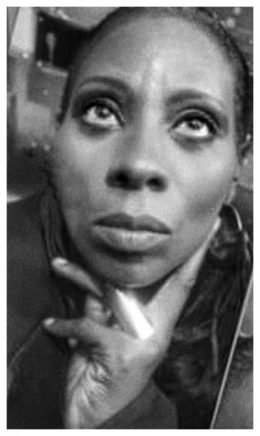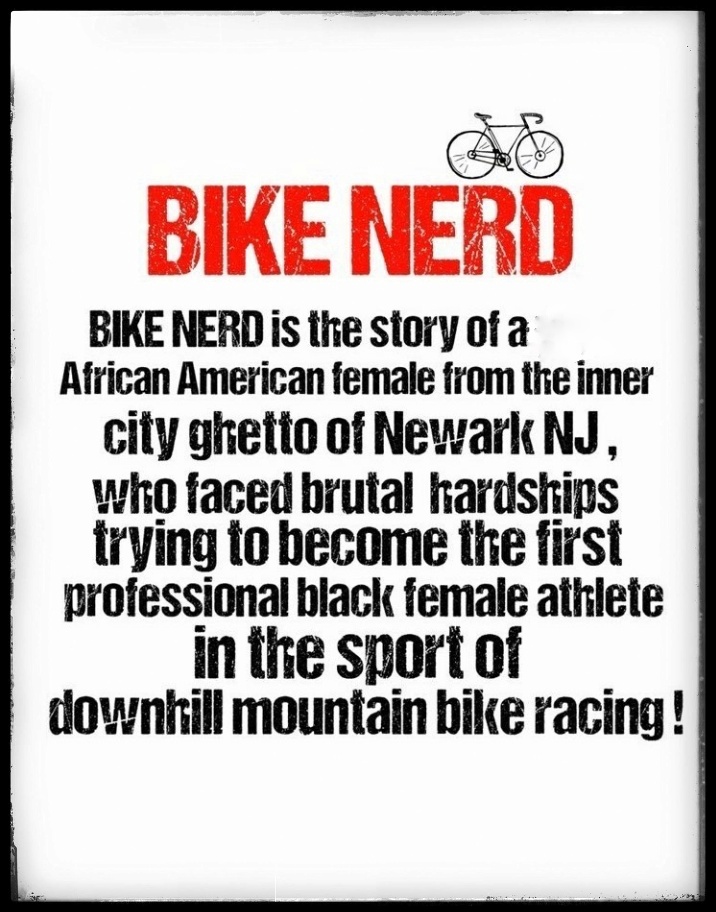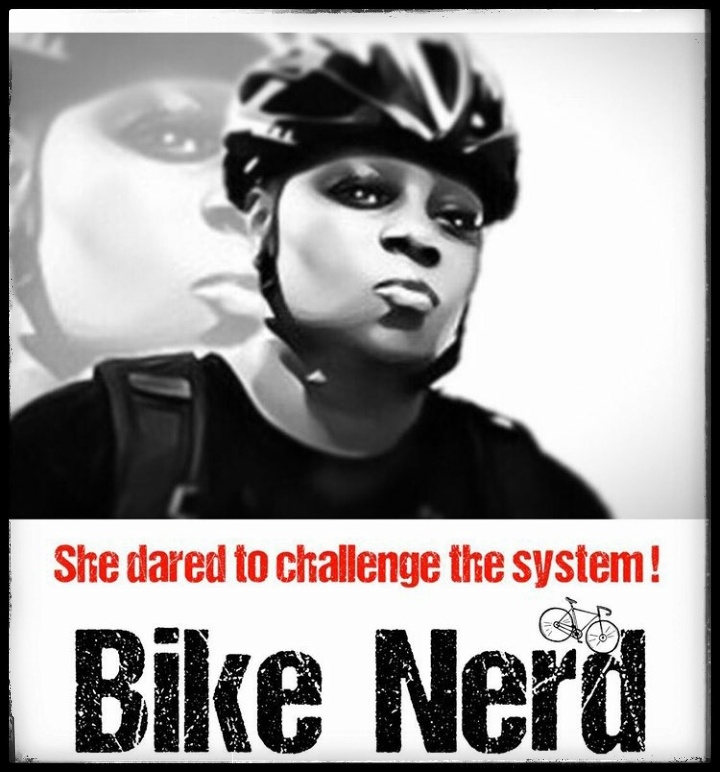THE OBSERVATION BOOTH

OP-ED BY ANDREA DIALECT
Part One
“It was approximately about a 45 minute ride back and forth every day from my residence to Newark International Airport where I was employed. That meant driving my bike on the highway and crossing over. As commuting when in that moment my mind space was very erratic, it was crazy and actually like an adrenaline rush. I also actually like riding my bike against traffic but I was very, very careful and very safety conscious at the time that I was actually doing it.
“I wanted to make a statement when I was riding my bike so; I would wear my extreme sports gear that I liked. I had this grand image of an extreme sports person in my head and that’s how I wanted to look when Id ride to work. The reaction that I’d get was like oh my God. The stares that I got from the mainstream public were crazy back then because they had never seen a black female on such a high-tech first generation full trek mountain bike with an extreme crazy hairstyle and clad in all of my gear. Today if I geared up, I’d get the same reactions!”
ROLL UP…
“The Bike Nerd”
Recreational & Commuter Cyclist

“I got into cycling as a Recreational and Commuter Cyclist. It started out as a recreational pursuit and that’s how I was able to discover the extreme sports downhill mountain bike racing market by being a recreational commuter cyclist. What that means is that wherever I needed to go I rode my bike. I used to have an expensive mountain bike at the time, and I would ride it from my house to my job daily as a commuter.
“Normally you’re advised to go with the flow and not to ride against traffic. But if you want to be safe you want to see the people in front of you, you’d want to be able to make eye contact with them. They can’t do that if you’re riding with traffic, and you can’t see what’s going on behind you and that makes your chances of getting hit increase.
TAKE COVER
“My aspirations were to make the transition from a commuter cyclist to break into the extreme sports world but that was not possible because of all the structural institutional racism and the amount of financial backing that I was lacking. The bicycle communities here local are very traditional and are not extreme sports orientated. Most don’t understand the image and the back-story of what extreme sports and mountain bike racing is all about. So as far as the community is concerned, I was on my own.
“The Extreme sports community wasn’t receptive at all. They were very, very racist, very, very disrespectful, and very, very closed-minded. Even though the resistance level was very high I still persisted, and I remained vigilant in my ideas and in my journey. As far as financial backing is concerned, we’re talking about a bare minimum of $100,000 in equipment, training, resources, and bikes and this was something I did not have access to as a black female living in Newark and in this state. Yes, you heard me correctly.
“One hundred thousand back then would cover the cost of health insurance, doctors, coaching, fitness training, racing license, your highly specialized bicycles, the equipment and parts that you’re going need for competition, travel expenses, you’ll also have to hire a licensed bike mechanic to work on your equipment. You’ll likely pay even more now. Let’s just say that one bicycle is not going to be enough to be a competitor. Mountain bike racing is apparently very expensive and very, very dangerous.
“You may have come across Annijke Wade’s story. She was an African American professional mountain biker who lost control of her bike while training in Angel Fire, New Mexico. Sadly, she is paralyzed now because of the injuries she sustained from that accident. Annijke had been recruited to be a diversity candidate but more so a poster child of sorts for the sport and had not been properly groomed, trained, or actually prepared for what being a mountain bike racer on that level entailed. Neither had she been given the proper mountain bike equipment and resources.
“As an athlete, because this is a high-risk sport it takes a substantial amount of money and training to be either competitive or on light trails. You must have insurance. Sadly Ms. Wade’s story can attest to that. Having insurance when participating in this sport is imperative; this is something that most people aren’t aware of when they’re on those trails. You’ll need a specialized form of life coverage if you’re going to be competing in bike competitions. If you’re going to just go off-road as a recreational athlete, you also need access to professional elite health insurance.
“Mountain bike racing is a recreational pursuit and cycling is a recreational pursuit and both are very, very dangerous and it carries an extremely high liability threshold!
MOVE
“Right now, I have an entry-level Cannondale road bike with carbon fiber wheels and my mountain bike is a carbon fiber traditional vintage bike. Which are both dated. I use both as a form of recreation and that’s it. These bikes are not utilized for any form of competition or off-road riding they are just used for recreational purposes. One downhill completive mountain bike could run you about seven or eight thousand dollars. As far as the gear is concerned besides its appeal it is really protective gear.
“One of the things you’ll need is professional body armor plates. You’d get fitted for the body armor, the helmet is essential because a cyclist is prone to get concussions and so on. At a professional level, I’d say that the age level is concerned maybe around fifteen to thirty-five. But, as far as the recreational sports level there is no limit.
OUTTA MY WAY
“I’ve traded in my pursuit of competition for driving things on the other side of the coin. The focus has always been and is now to break down barriers and break down doors as far as imagery, marketing, and branding that’s one issue. The other is to create more advocacy and diversity in the industry and also to create a shock value because the industry of mountain biking and extreme sports still have not seen a black female for the most part. I would like to create a change in the industry, and I would like to open doors for those that are looking to come into the industry behind me.
“Don’t get me wrong there are a couple of black females out there that rep us in the industry. There’s a female that has broken in recently who is a professional road cyclist and another black woman who is a downhill mountain bike racer, but that’s it. Even though because of those barriers that I was up against I never actually got the opportunity to participate in a competitive race. I am still documented as the person to initially break into the industry. My being documented as the first black female who initiated the start of change is a blessing. But even more so to have been the person who broke that barrier although I hadn’t been given the chance to physically compete.
“I am no longer in pursuit of competition. But I am in the pursuit of building awareness and making change. When up against those challenges way back when I created an extreme sports marketing plan that I still have to this day that I would be utilized as a part of my experience to make my film.
“Upon its release, the film is going to expose a lot of the class, race, and gender barriers that still exist to this day. I’m glad to have had the opportunity to share my insight and give you a peek into my story. “Be on the lookout for Part two of the Ultimate Bike Nerd. I have a lot of amazing and informative things to share. In all honesty, this sport is not a solo pursuit; promoting change in this industry like all others is a team sport. So, let’s come together and promote change!”


